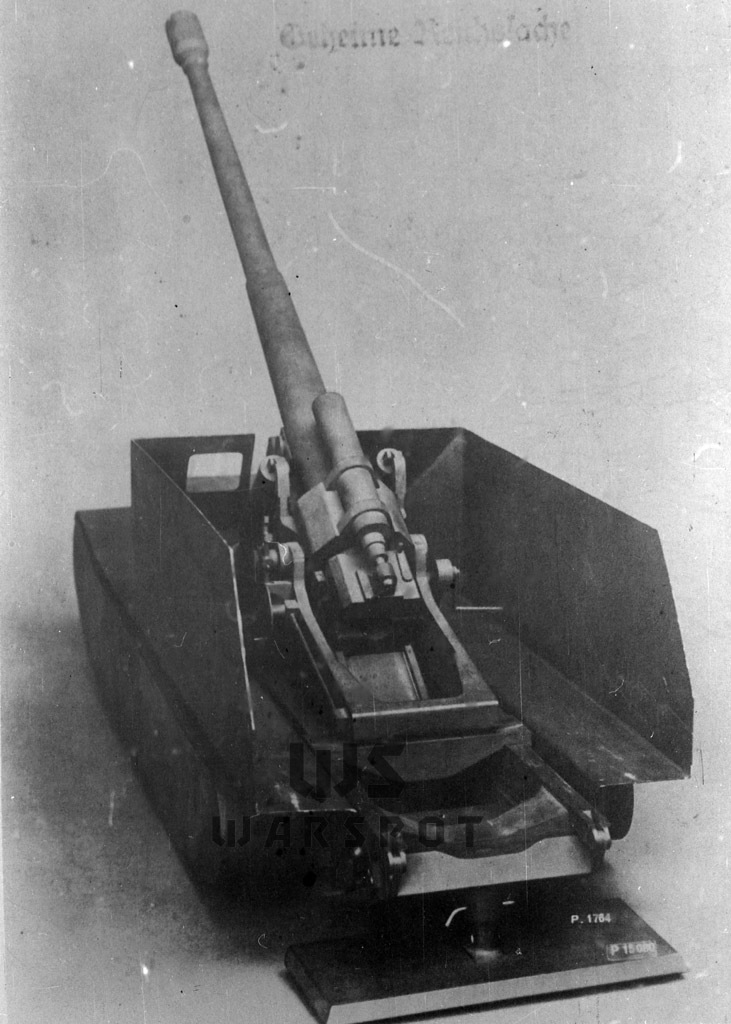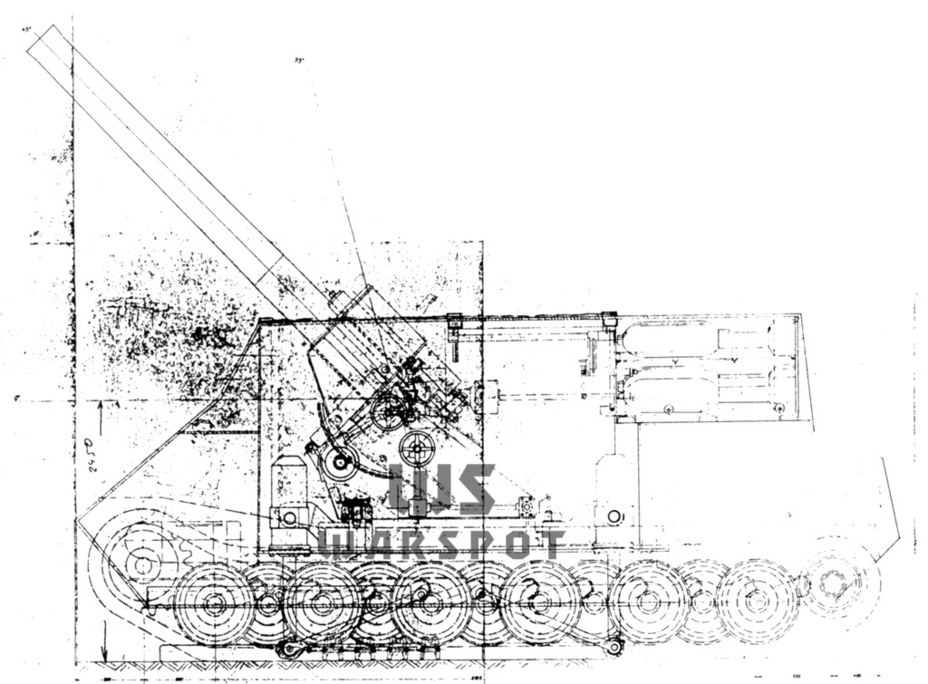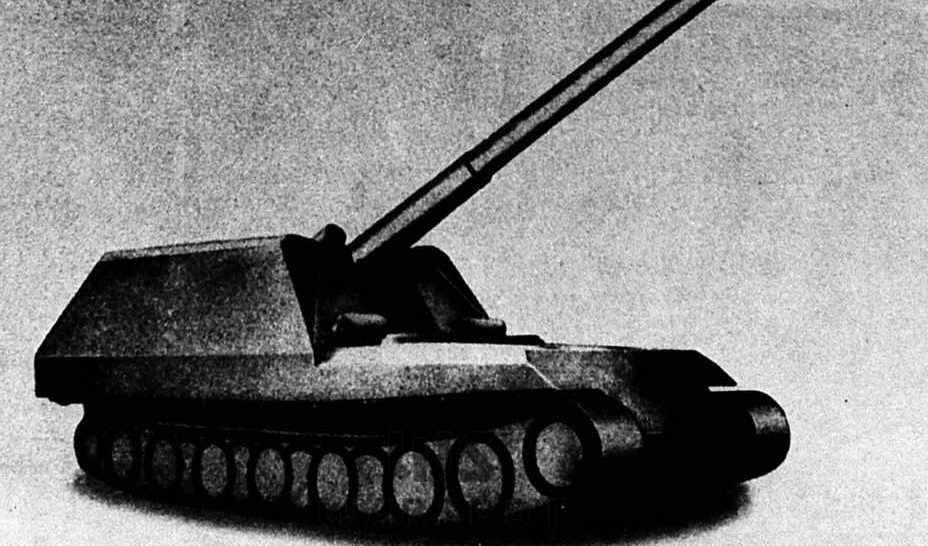You can find the original post by following this link: Warspot by Yuri Pasholok. The following text is directly translated from the Russian text.
Larger self-propelled carriage

The history of the Hummel self-propelled guns is well known, but in reality, they were not the only such machines. In the spring of 1942, a program was launched to create “self-propelled carriages,” better known under the designation Grille. This family had no relation to self-propelled installation on the Pz.Kpfw.38 (t) chassis. According to available data, the Grille 10 (105 mm L / 35 howitzer), Grille 12 (128 mm L / 50 gun) and Grille 15 (149 mm L / 35 gun-gun) were originally planned. The base was considered, first of all, the chassis of the VK 30.02 (M), which later turned into Pz.Kpfw. Panther.
It should be noted that under the designation Grille 12 and Grille 15 there were a number of projects that were very different from each other. Finally, on May 6, 1942, another project appeared in the correspondence – 17 Kanone L / 50 in Sfl. At first, the base for this vehicle was not registered, only the combat weight was indicated – 37 tons. A rather high maximum speed of 40-50 km / h was expected. According to the specification, the rate of fire was 2 rounds per minute. If in the case of the chassis there wasn’t much data, the gun was well known – 17 cm Kanone 18. The gun, which had a real caliber of 173 mm, was relatively in mass production (338 pieces were made in total), and was very heavy (17.5 tons in combat position ). Bringing him into a fighting position was a rather long process.

The gun was based on the carriage of a 211 mm howitzer 21 cm Mörser 18, so it was fully named 17 cm Kanone 18 in Mörserlafette. The peculiarity of this gun carriage was that in the combat position it was placed on a large central support, while circular rotation was ensured. On May 6, the same project appeared under the designation Selbstfahrlafette mit 17 cm K bzw. 21 cm Mörser… The machine was developed by Krupp, and the project was personally supervised by Erich Mueller, Krupp chief designer.

A model of 17 cm K Sfl. was ready by July 3, 1942, then it was demonstrated to Hitler. It is believed that the tank was based on the VK 45.02 (H) chassis. Rather, it is worth saying that Krupp worked closely with the 6th Division of the Department of Arms, and from there came instructions on the chassis. Knipkamp directly supervised the issue, with 17 cm K Sfl. received some elements even earlier than VK 45.02 (H). For example, in July 1942, the Maybach HL 230 motor with an expected power of 750 hp was already featured. (the original design involved a 650-horsepower Maybach HL 210), Henschel KL 800/320 tracks, and a ZF-Alklauen AK 7-200 manual 7-speed gearbox. Everything listed in the correspondence on VK 45.02 (H) appeared already in August 1942. In addition, Knipkamp expected to get a maximum speed of 60 km / h – at least the chassis should have provided just such an indicator.

On August 14, 1942, a regular meeting was held, attended by Mueller, Knipkamp, Wolvert and others. It decided to make a full-size model 17 cm K Sfl., While it had some differences from the first layout, another change occurred in September 1942 – then the Grille 21 designation was first used. Another designation was Gerät 5-1702 – it was used by OKH. A month later, the most commonly used designation appeared – Grille 17/21.
Design in variable conditions
Finally, the appearance of Grille 17/21 was formed in early 1943. VK 45.02 (H) had a great influence on the project, as the self-propelled gun base was repeatedly changed. The unification requirement forced Krupp to operate in the VK 45.02 (H) wake. In any case, the drawing of AFK 70215 of January 22, 1943 already gave a general idea of the combat vehicle. In the final version, the chassis was heavier, the combat weight was estimated at much more impressive 55 tons. At the same time, the maximum speed dropped to 48 km / h.

The overall concept of Grille 17/21 has not changed much from the original project, this meant installing a hole-type muzzle brake on 17 cm Kanone 18 or 21 cm Mörser 18, which was necessary to reduce recoil. Moreover, the Grille concept implied (if necessary) the operational unloading of the gun from the chassis, after which the wheels were put on it, the same as on a regular carriage – the gun became towed.

Compared to the 17 cm K Sfl. Model, which was shown to Hitler in July 1942, the final version of the Grille 17/21 project has changed significantly. Initially, it was assumed that the tank will have the same chassis as the VK 45.02 (H). However, it quickly became clear that in order to ensure normal conditions for placing the guns and aggregates inside the machine, the body would have to be significantly extended. As a result, the original layout left the general layout, as well as the concept of placing the gun (along with the standard carriage) in the fighting compartment. The length of the case increased to 9500 mm, which in many respects explained such a substantial increase in the combat mass.

At the same time, the thickness of the armor, like that of other “self-propelled carriages,” was significantly lower than the base tank. The forehead of the case had a thickness of 30 mm, and the remaining sheets – 16 mm. To nine pairs of road wheels, one more pair was added to the front and rear (they compensated for the increased length of the hull).

The crew of Grille 17/21 was 8 people, of which two were located in the management department. No communication was provided with the combat compartment, since the engine compartment was located immediately behind the control compartment. As of the end of January 1943, the ZF-Alklauen AK 7-200 gearbox was still provided for the Grille 17/21. According to the results of all changes in June 1943, a new gearbox appeared – Maybach OLVAR OG 40 12 16B.

According to popular information, in April 1943, Hitler ordered the suspension of the chassis in order to increase the production of tanks. Theoretically, it is, but practically not. On the topic of Grille 17/21 and after April 1943 there was a real shaft of correspondence between Krupp, Henschel, OKH, as well as the 4th and 6th divisions of the Department of Arms. It seems that either Hitler’s instructions were not a decree for any of the participants in the correspondence. In the fall of 1943, the tank was often referred to as the Grille 17/21 mit einbauteilen Tiger II – this meant maximum unification with the Pz.Kpfw.Tiger Ausf.B. The correspondence constantly indicated the dates of delivery of individual units and assemblies, which all the time shifted by date. In September 1943 it was believed

On August 4, 1944, a revised version of the Grille 17 was prepared. The combat weight increased to 60 tons, and the maximum speed dropped to 45 km / h. The overall layout of the chassis remained almost unchanged, but at the same time worked out the design of the control compartment in more detail. The driver received a sighting device similar to what was developed for the Type 180 heavy tank in the fall of 1942, and later transferred to VK 45.03. The radio operator received a ball mount machine gun. Regular alterations were made to the design of the fighting compartment. Instead of silencers, straight-through pipes appeared. Finally, in the final version of Grille 17/21 (in the bow of the hull) there was a stopper for installing the gun in the stowed position.

In parallel with the development of documentation, work was underway on the prototype part. At Krupp, a wooden mock-up of the fighting compartment was made, in which they worked out the layout of the deployment of calculation and ammunition. There was a clear misfortune with the latter. For 17 cm Kan 18, only 5 shots were provided, and for 21 cm Mrs 18 – only 3. Thus, the machine had to work together with ammunition carriers.

The development of documentation for the tank was completed somewhere in mid-September 1944. Then the team for the manufacture of a prototype machine followed. As weapons, it was supposed to use a 173-mm Kanone 72 cannon (in fact – Kanone 18 with a muzzle brake). In this regard, the tank in correspondence went under the designation 17 K.72 (Sf) GW.Tiger. One could also meet the designation Geschützwagen Tiger für 17cm K72 (Sf), which is essentially the same. The construction team was given clearly at the wrong time: six months before these events, the chances of making a prototype would have looked high, and at the end of 1944 Krupp was bombed with enviable regularity. For this reason, it was actually possible to partially complete the chassis, which was sent to the Henschel training ground in Haustenbeck (near Paderborn). There were attempts to finish it, but the work moved extremely slowly. The latest information on the 17 K.72 (Sf) GW.Tiger is dated February 1945 – the machine was still expecting tracks and other components that never arrived.
Very big trophy
In early May 1945, the Henschel training ground in Haustenbek was captured by the Allied forces. Representatives of the British and American military intelligence immediately arrived here. A joint study of the materiel located in Haustenbek began. I must say, the Allies were very lucky: at the Henschel training ground there were prototypes of most heavy tanks and self-propelled artillery installations that were developed by this company. For example, it was here that the prototype of the super-heavy tank E-100 was waiting for its fate.

In addition to the 17 K.72 (Sf) GW.Tiger, which in the Anglo-American correspondence appeared under the name Grille, there was a Kanone 72 gun at the test site. By the way, some researchers confuse it with a gun for the super-heavy tank E-100. The truth is that the E-100 gun was not supposed to have a muzzle brake.

The impression is that the British and Americans were not very impressed with the German heavy self-propelled gun. Despite the fact that in terms of completeness 17 K.72 (Sf) GW.Tiger was much higher than the same E-100, little attention was paid to this machine in the reports. A few paragraphs are all that is contained in each of the two reports compiled in May 1945. One of them can even confuse researchers – the British military counted as much as 120 tons of combat weight, that is, doubled it.

The further fate of the car was sad. Finish the construction of 17 K.72 (Sf) GW.Tiger did not, although it was quite possible. Instead, the self-propelled gun was loaded onto a German trailer designed for the transport of superheavy goods, and taken to England. In order for the machine to fit into the dimensions, the upper deck sheets were undocked and thrown inside the fighting compartment. In this form, the trophy was delivered to England. Like other models of equipment from Haustenbek, later 17 K.72 (Sf) GW.Tiger went to scrap. Actually, of all the tanks found there, only Jagdtiger and the second released instance of Pz.Kpfw.Tiger Ausf.B were survived.

In conclusion, it is worth mentioning a couple of projects that are directly related to the history of Grille 17/21. We are talking about developments that were carried out jointly with Škoda. In Pilsen, under the “cap” of the SS, work was underway on a number of models of artillery weapons. Among them was an extra-heavy 305 mm mortar (30.5 cm schwerer Granatenwerfer). Its development began in January 1945 and was completed in 20 days. In April 1945, they managed to make a prototype – a 160-kg mine could fly at a distance of up to 10 km. It is much more interesting that at the same time a self-propelled version of the mortar was developed – 30.5 cm schwerer Granatenwerfer in Selbstfahrlafette. The base used was the Pz.Kpfw.Tiger Ausf.B chassis, extended by two rollers. The combat weight of the vehicle was to be 55 tons. Before firing, a special emphasis was placed under the belly of the car. Smaller than Grille 17/21, the mass was explained by the fact that inside was only the swinging part of the mortar. The ammunition is unknown, but it was clearly larger than the Grille 17/21.

At the same time, Škoda worked on an even more powerful mortar – 42 cm schwerer Granatenwerfer. Work on it began in February 1945. The mortar had a similar firing range, but the mass of the mine was much larger – 400 kg. However, they did not begin to build it, since the design weight was too large – 21.6 tons. It is characteristic that a self-propelled gun – 42 cm schwerer Granatenwerfer in Selbstfahrlafette was also designed at Škoda. In general, it was similar to a 305-mm self-propelled guns, but the dimensions became larger, as did the lowering stop. The combat weight was an impressive 65 tons. Both projects did not go beyond the stage of sketches, however, they were of considerable interest – they were the most powerful self-propelled guns that were developed on the basis of the Pz.Kpfw.Tiger Ausf.B.
Sources and literature:
- BAMA (Bundesarchiv)
- NARA
- Der Panzer-Kampfwagen Tiger und seine Abarten, Walter J. Spielberger Motorbuch verlag, 1987, ISBN 3-87943-456-5
- WWII German Experimental Military Vehicles, Ground Power Special Edition, 2003
- Panzer Tracts 10 – Artillerie Selbstfahrlafette, Thomas L. Jentz & Hilary L. Doyle, Darlington Productions, Inc, 2002

